Review: The Blazing Hour
In the September of 2024, the Fifth Doctor Adventures range promises a six-part adventure of grand proportions, written by James Kettle. Though at the time of writing this review, The Great Beyond is still a short way off, so what better time than now to look at Kettle's previous experience writing for the Fifth Doctor with The Blazing Hour.
 |
| The era-appropriate variant of the cover art, by Tom Webster. |
In the far future, the planet Testament is the backbone of the human race, providing them with the vast amounts of power they need to travel the stars and continue to expand. Under pressure to keep profits going up and growing fast, an experiment is being carried out to exponentially increase its power output, an experiment that researcher Ellison believes will go horribly wrong. The Doctor and companion Turlough arrive, and before long all hell breaks loose.
The first part is a wonderful introduction to the world of the story and sets the tone for all that's to come. As high as the stakes are set, the story is primarily a comedic romp. James Kettle's political commentary is anything but subtle and the story is all the better for it. The argument could be made that taking things to such a facetious extreme - from talk of having farm workers sleep in the silos to maximise working hours, to disregarding the imminent end of a great chunk of the universe as something to put off until next Easter, whenever that is - defangs the commentary, but it largely manages to avoid this by providing an underlying cruelty that helps ground the whole thing.
The cruelest of all being the Levison jar, a terrible device used to freeze "saboteurs" in a single moment in time, suspended forever and unable to ever be set free. It's not hard to read between the lines, this is how they handle protestors in this world and the fact that only the Doctor, Turlough and other protestors see this as a bad thing gives a pretty good idea of how they're percieved by the ordinary people of this world, an idea that's aged disappointingly well since release.
When things go disasterously wrong, the Doctor finds himself crushed under the slow-moving wheels of bureaucracy. Having been able to take things to the highest level - the prime minister of the solar system - he finds that no matter what he does to convey the severity of the situation and the need for immediate intervention, the government has no intention to actually do anything until it's too late. You'd be forgiven to think with all the lives at stake - and the prime minister's lack of empathy - this is all a bit of comedic exaggeration, but this story was recorded at the end of 2020 and likely written earlier that year. Cast your mind back to how the British government handled Covid-19 pandemic (which this story has no trouble making me do) and the Doctor's quickly growing frustration feels all too relatable.
One aspect where the story's commentary falls flat is with the Testamentarians themselves, the native population of Testament, where humans have also made their home. The story is definitely going for an allegory for racial inequality, they're consistently depicted in subordinate positions to human characters (even when we meet Testament city's kindly leader, he's answering to someone else), while human characters often make passing remarks that serve to put them down. This aspect of the story doesn't really come into focus though, early on Turlough observes that the human-Testamentarian relationship seems ammicable, and the story doesn't really do a lot to suggest otherwise. Perhaps it would've been too tonally out of place.
Kettle's writing is simply just really funny too, it'd be very easy for this review to devolve into a long list of quotes and exchanges, a personal favourite bit of dialogue is when Ellison is asked by Horobin (her superior) if she knows what the penalty for insubordination is, she in return asks if it's death and Horobin corrects her: "Worse - unemployment!" The line is delivered beautifully by Raj Ghatak, Horobin's voice filled with such abject horror.
Horobin is a great character in general, becoming increasingly unhinged throughout the story unable to deal with his reality being challenged, but the true star of the show is Violet Hardaker, a very manipulative character focused on saving her own skin, with plenty of great lines. Her interactions with the Doctor are her best, especially when helping the Doctor navigate the political system.
Turlough spends much of the story relying on another character - Fionn - to get him out of the scientific installation on Testament. He has a small arc in the story where he appreciates Fionn's courage and wants to find that within himself. It doesn't go too far but it's a nice little addition that feels right for the character at this point in his journey.
Final Thoughts
If you're looking for a laugh a minute that comes with a bit of a bite, The Blazing Hour is without a doubt the story for you. There are bits and pieces of drama in there that don't quite get to realise their potential but it leaves me all the more excited for what's to come next from James Kettle.
If this review has sparked your interest, The Blazing Hour is available at https://www.bigfinish.com/



Comments
Post a Comment